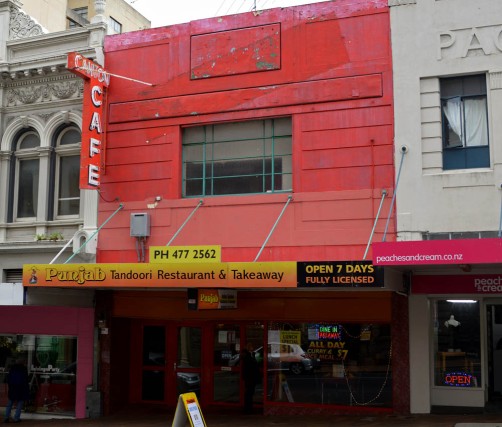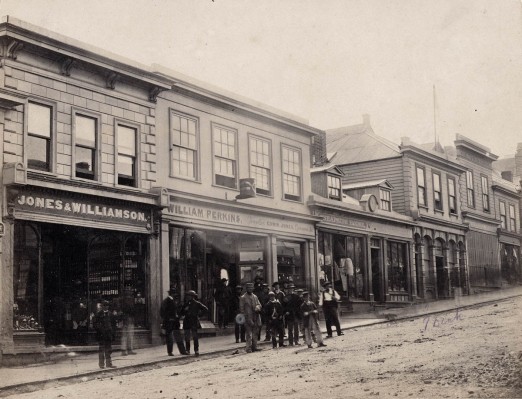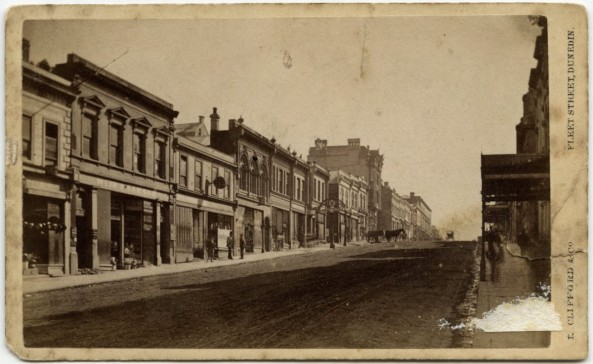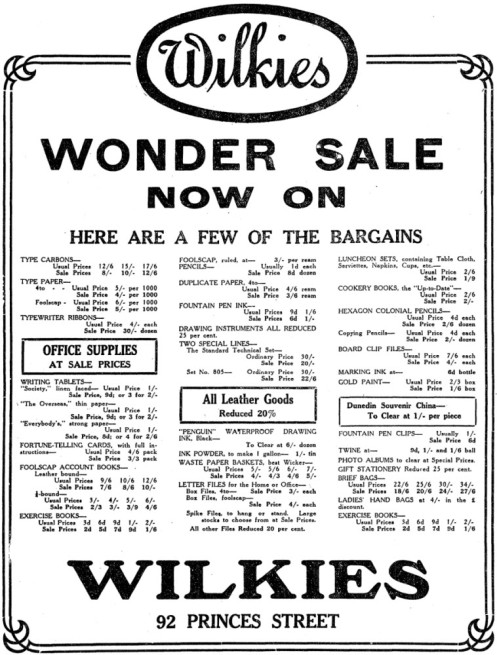Built: 1866, remodelled 1939
Address: 192 Princes Street
Architects: R.A. Lawson (1866), Clere, Clere & Hill (1939)
Builders: Not identified (1866), W. McLellan Ltd (1939)

A bright red facade in Princes Street invites the attention of passers-by, but few would guess that behind this 1930s front is a 150-year-old building.
Its story begins with John Switzer. Born in Winchester, Hampshire, in 1830, Switzer was the son of a bootmaker. He followed his father’s trade and after a period in Australia arrived in Dunedin with his wife and infant daughter in September 1857. Within two months he established a boot and shoe warehouse, later named Cookham House after the ‘Cookham’ hobnail boots imported from England. There was a similarly named business in Christchurch, owned by George Gould. Switzer sold his business in 1863, not long before opening a new Cookham Store in Rattray Street.

John Switzer. Ref: City of Victoria Archives, Canada, M00235.
Switzer was a director of the Dunedin Gas Light & Coke Co. and his many other business ventures included Hyde Home Station in Southland. He only owned the property for a year, but the gold rush township afterwards established there was called Switzers after him. It later became known by its present name, Waikaia. John’s wife Harriet introduced European birds to Otago, including starlings, blackbirds, and thrushes. The Switzers owned a small farm, Grand View, in Opoho.
In 1864 Switzer was a shareholder of the new Dunedin Boot and Shoe Company. He became the manager of its outlet opened under the familiar Cookham House name, on what is now part of the Southern Cross Hotel site on Princes Street. At the end of 1865 the company decided to move a block north, to the address that has since become 192 Princes Street. The building then on the site was occupied by the auctioneers G.W. Moss & Co., with offices above known as Princes Street Chambers. It was only a few years old, but being wooden it belonged to a preceding era and was already out of date.

An 1864 photograph of Princes Street. The building on the right of the lower one with the dormers was on the site of the present 192 Princes Street. Ref: Collection of Toitu Otago Settlers Museum.
Architect R.A. Lawson called for tenders for a new building in December 1865. This was early in Lawson’s career. The design for First Church that had brought him to Dunedin was yet to be built, but he was well-established after three years living and working here. His design for the Boot Company was brick, with a bluestone basement and an Oamaru stone front. The Otago Daily Times promised it would be a ‘handsome structure’. It was representative of a new class of building in Dunedin, as the wealth brought by the gold rush began to be reflected in the buildings of the new city.
Photographs show an elaborately ornamented Gothic Revival facade. First-floor decoration included clustered pilasters with Corinthian capitals, grapes and floral decoration, and a carved head in the keystone above the central window. A verandah was built, but despite being approved by the Building Surveyor it fell foul of building ordinances and the City Council would not allow it. It seems the verandah was removed, as it does not appear in a photograph taken in the 1870s.

J. Wilkie & Co. and Eldon Chambers in 1923. At this time the building retained most of its original appearance, though the shop front had been rebuilt and included leadlight windows. Ref: Coulls Somerville Wilkie records, Hocken Collections MS-2248/031.

Facade detail. Ref: Coulls Somerville Wilkie records, Hocken Collections MS-2248/031.
The upper part of the building was named Eldon Chambers. This followed the original Eldon Chambers in London, which took their name from the English barrister and politician Lord Eldon (1751-1838). The name was repeated in many locations in Britain, Australasia, and elsewhere (there were at least seven Eldon Chambers in New Zealand alone), typically for buildings with rooms for lawyers and other professionals. The first occupants of the Dunedin chambers were Prendergast, Kenyon & Maddock (lawyers), George Brodie (inspector of bankruptcy), Dick & Fleming (land agents etc.), Dr Alfred Eccles, and H.F. Hardy (architect).
In 1867 Lawson designed two adjoining buildings for Matheson Bros and J.W. Robertson. These were given a much simpler facade treatment, but integrated with Eldon Chambers through the continuation the parapet cornice and other details in the same style.
In March 1867 a fire broke out in the cellar of Swizter’s building, but damage was confined to that space. Evidence at the inquest exposed the precarious state of Switzer’s finances. He had bought the stock and trade of the company a few months before, and suspicion was raised that he set the fire to get the insurance money. He was charged with arson. The trial took place over six weeks and ended with Switzer’s acquittal, but in the meantime he was bankrupted. Once his affairs were settled he left New Zealand for London, and a few years later emigrated with his family to Canada.

Princes Street in the 1870s. Eldon Chambers is the fourth building from the left. Ref: Collection of Toitu Otago Settlers Museum. R. Clifford & Co. photograph.
After Switzer’s departure his old shop was occupied by a succession of tailors, before the printers J. Wilkie & Co. opened a warehouse and stationery factory. The firm made various additions at the back to cope with their expanding business, and in 1892 moved their manufacturing to another site, keeping a warehouse and retail shop in Princes Street.
A full list of those occupying Eldon Chambers would be too long to list here, but some had particularly long associations. A connection of over thirty-five years belonged to the Dick family: the parliamentarian Thomas Dick and his son Thomas H. Dick were commission agents. An even longer record belonged to Herbert Webb, who had rooms for over fifty years. His succession of law firms in Eldon Chambers began with Dick & Webb in 1877. This was followed by Duncan, Macgregor & Webb, then Herbert Webb’s sole practice, and finally Webb & Allan. Herbert Webb died in 1928, after collapsing on the nearby Dowling Street corner. His old firm moved out in 1930 but its successor, Webb Farry, is still in existence.

A.C. Hanlon (1866-1944)
Alfred Hanlon, admitted to the bar on 20 December 1888, took an office in Eldon Chambers in New Year 1889. He furnished it with a plain deal kitchen table covered with oilcloth, three cane chairs, and a letter press. He waited three months for his first client. He later wrote:
‘I was now thoroughly daunted, and I think that at times I almost hated the office and all its associations. Little wonder then that I could not dissemble my eagerness whenever I heard a footstep outside the door. The months dragged hopelessly by, and still boy enough to be moved at their passing, I bade each a melancholy farewell. It came to this, that every time I heard a step I trembled. Would it reach my door? With feverish haste I would fling open my largest law book – “Benjamin on Sales” – on to the table, and when the knock came my too studiedly casual “Come in” arose from a head buried in the large tome. But it was all to no purpose. My carefully staged scene made no impression, because the caller was always another debt collector.’
Eventually Hanlon got a case defending a pedlar known as Dr Shannon from a charge of purchasing a bottle of Hood’s Corn Solvent under false pretences. He was successful and the case was dismissed. Hanlon was ten years in Eldon Chambers and in that time became one of New Zealand’s most celebrated criminal lawyers. In 1895 he famously but unsuccessfully defended the so-called ‘Winton baby farmer’, Minnie Dean, the only woman hanged by the State in New Zealand. It was probably in Eldon Chambers that he wrote his famous brief, now preserved in the Hocken Collections. During a fifty year career Hanlon was retained in twenty murder trials and he was made a K.C. in 1930.
Wilkie & Co. merged into Coulls Somerville Wilkie in 1922, but a shop specialising in stationery and gifts continued to trade under the name Wilkies until 1927. It was then rebranded under new ownership as Bells Limited, and remained on the site until 1939.

A 1927 advertisement for Wilkies from the Otago Daily Times. Ref: Papers Past, National Library of New Zealand.
In 1939 the building was extensively altered to the designs of Wellington architects Clere, Clere & Hill for new owners Boots the Chemist. This pharmacy chain had been established in England in 1849 and set up its New Zealand operation in 1935. The Oamaru stone facade was removed and an entirely new front in brick and concrete was built in the streamline Moderne style. Staircases and columns were removed from the interior and new beams were installed. W. McLellan Ltd were the builders. According to the Evening Star:
‘The external appearance of the building has been carefully thought out. Black terrazzo and bronze metal have been used to telling effect for the double window fronts. An innovation for Dunedin consists of the huge Neon signs which are recessed so that they appear to form an integral part of the building. The whole layout has been designed with an eye to a keynote of solidarity and permanence. Although appointments are modern, as is evidenced by the glassed-in dispensary, open to the public eye, simplicity has been the primary aim. There is a complete absence of such materials as chromium plate – anything, in fact, which may prove subject to the dictates of fashion. Instead, the furnishings are carried out in light-stained oak. The surgical section is finished in white enamel, and the surgical fitting room – particularly spacious for this purpose – is carried out in white and navy blue. Lighting is exceptionally good, and the floors are finished with ‘Rublino,’ a particularly durable covering. A completely new fibrous plaster ceiling was, of course, necessitated by the extent of the alterations. At the rear of the shop are store rooms and offices, tea rooms, and toilets for the assistants.’

The building following alterations for Boots the Chemists completed in 1939. Ref: Coulls Somerville Wilkie records, Hocken Collections MS-2248/034.
In 1959 the Hob-Nob Coffee Garden was built in the basement for owner-operator Ted Paterson. The café was a good place for a toastie pie and coffee, and was known for its cheese rolls and corn rolls. The Hob Nob lasted until about 1970 when it briefly became the Van Dyke Expresso Bar [sic]. It was the Hibiscus Coffee Garden for approximately eight years, before its closure around 1979.
In its heyday Boots employed as many as seventeen staff in its Dunedin shop. After 50 years in Princes Street it closed its doors in September 1990. A company executive from Wellington said: ‘The city fathers have killed that part of town. Once it was the prime business area in the city. Now it is disgracefully tatty.’ He thought Boots should have pulled out years before, but ultimately the parent company had decided to close all of its retail outlets in New Zealand.
Rebel Warehouse was in the building for a year or two before the New Canton Restaurant moved there in 1993. The original Canton Café had operated from a building on the opposite side of the street since 1961, and from 1978 under the ownership and management of Kee and Sanny Young. Mrs Young, who grew up in Macau and Hong Kong, was the chief cook. She later recalled: ‘You couldn’t get Chinese food then. No bean sprouts, or pastry, or noodles … It was very difficult to buy our food, so we opened the restaurant. But it was too busy. We could only seat 50 and lost bookings, so … we moved across the road to here’.
The New Canton closed in February 2013 and the Punjab Restaurant has since taken its place – the latest chapter in a century and a half of business activity at 192 Princes Street.
Newspaper references:
Otago Witness, 5 September 1857 p.4 (shipping notice), 21 November 1857 p.4 (advertisement for John Switzer, boot maker), 22 October 1864 p.13 (blackbirds and starlings), 27 May 1865 p.4 (thrushes), 6 July 1867 p.3 (sale of Grand View Farm); Otago Daily Times, 26 May 1863 p.1 (advertisement for Cookham Store), 28 May 1863 p.6 (Dunedin Gas Light & Coke Co.), 6 August 1863 p.3 (sale of business to Trood), 8 March 1866 p.4 (verandah), 20 March 1867 p.4 (fire), 25 April 1867 p.5 (inquest into fire), 24 June 1867 p.5 (trial and verdict), 20 September 1867 p.5 (Matheson Bros and J.W. Robertson buildings), 3 October 1877 p.3 (Dick & Webb), 22 December 1888 p.2 (Hanlon admitted to bar), 5 March 1889 p.4 (Hanlon’s first client), 5 May 1927 p.3 (advertisement for Wilkies), 21 March 1928 p.7 (Herbert Webb obituary), 21 September 1990 p.5 (closure of Boots), 22 September 1990 p.8 (editorial re closure), 17 January 2013 p.1 (closure of New Canton); Dunstan Times, 27 July 1866 p.4 (advertisement for Dunedin Boot & Shoe Co.); Evening Star, 12 December 1939 p.3 (alterations for Boots).
Other references:
Blair, E.W. and E. Kerse. On the Slopes of Signal Hill (Dunedin: Otago Heritage Books, 1988).
Catran, Ken. Hanlon: A Casebook (Auckland: BCNZ Enterprises, 1985).
Cyclopedia of New Zealand, vol.4, Otago and Southland Provincial Districts (Christchurch: The Cyclopedia Company, 1905), p.357.
Donaldson, Janine E. Seeking Gold and Second Chances: Early Pioneers of Waikaia and District (Waikaia: Waikaia Book Committee, c.2012).
Hanlon, A.C. Random Recollections: Notes on a Lifetime at the Bar (Dunedin: Otago Daily Times & Witness, 1939).
Dunedin City Council building records
Directories (Harnett’s, Stone’s, Wises, and telephone)


































